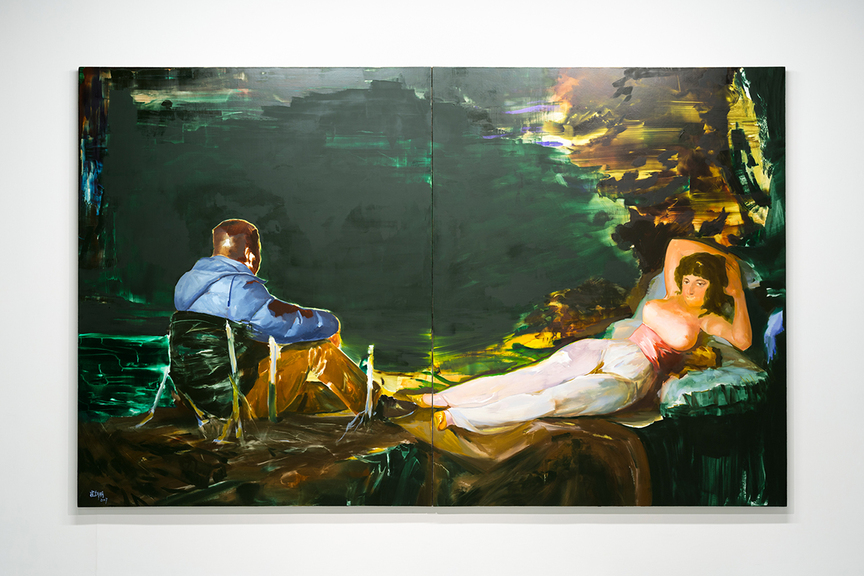-
From Current Issue
-
- Editor’s Letter Fire in the Heart
- Reviews I Gusti Ayu Kadek Murniasih
- Reviews 11th Seoul Mediacity Biennale: “One Escape at a Time”
- Dispatch Networked China
- One on One Monira Al Qadiri on Yukio Mishima
- Essays The rise of independent art spaces in pandemic-era Shanghai
- Features Tuan Andrew Nguyen
- Table of Contents
- Web Exclusives
- Archive
- Subscribe

R
E
V N
E
X
T
Cui Xinming’s exhibition at Edouard Malingue Gallery, Hong Kong, started with Genre Painting Study 5 (2017). Placed at the space’s entrance, the work comprises a pair of paintings that each depict two miners, caught in the exact same positions—the figure on the left gripping onto a horizontal line that cuts across the canvas, while the duo march together to a destination beyond the frame. The only difference is that in the left panel, the scenario is rendered in a cool purple from a distance, while the composition on the right is a detailed view, colored in a palette of warm browns. What ties the two directly together is the horizontal line, which is carved into both paintings at the same height. Several other scratches are visible throughout the work, referencing printmaking techniques, particularly woodblock carving. The proletariat and woodblock prints—these form the tenets to what Chinese intellectual Lu Xun described as the avant-garde in the early 20th century—and this, in turn, was the first hint of the core of Cui’s show.
In the textual introduction to the exhibition, the artist is introduced as “one who is somehow close to the subjects portrayed yet vaguely distant, able at once to straddle objective deliberation and sentimental evocation” through his art. Yet, while this may be true, this notion doesn’t really touch on the crux of Cui’s works—his paintings are ultimately engaged with art history itself. Genre painting is a European tradition based on depicting the everyday life of the working class. If the work at the gallery’s entrance is a study of the typology, as the title suggests, Cui is answering to such a tradition—with a twist. Cui’s works, including the other exhibits of “Differentiation,” can be interpreted as collages that combine European symbols and approaches to image-making, particularly those from the Renaissance and Romantic period, with that of 20th and 21st century China, drawing parallels between the two disparate narratives to comment on the state of Chinese society.
A direct embodiment of this can be found in Portrait Study 8 (Pamper) (2017), displayed opposite Genre Painting Study 5. The painting features two faceless figures, posed against a non-descript sierra ground. The only details that distinguish the two from the backdrop are their roughly painted clothing. Unlike traditional Renaissance portraits, which show off the privileged social statuses of noblemen, there is nothing glorious about this work. The humbly dressed maid on the left faces away from the figure on the right, whose garb, although clearly denoting his status as royalty, is stripped of any jewels. The emperor, traditionally understood as “the son of God,” represents androcentricity—the court he ruled over would have been comprised solely of men. The rose that he is holding, however, is an early Renaissance Christian symbol of the Virgin Mary that recalls motherly qualities. Seen in this light, Cui is putting together the two extreme symbols of masculinity and femininity onto the same canvas. Through these interactions between different symbols, Cui deglorifies male power and depicts the fall of the Chinese monarchy in the early 20th century.
The show also comprised tongue-in-cheek paintings that purportedly explain art. Following on from the dissolution of China’s last dynasty, Portrait Study 6 (How to Explain Painting to My Hometown)-R (2017) is set in post-Cultural Revolution China. The work humorously represents the artist’s struggle of explaining his artistic career to his friends at home where art education is absent. Its central subject is a reclining woman who mirrors the posture and facial expression of Maja, the female figure in Francisco Goya’s La Maja Desnuda (c. 1979–1800). Cui’s addition to Goya’s composition is an ordinary man in a blue hoodie who sits with his back to the viewer, while Maja gazes outward from the picture plane with a pair of white silk pants added over her lower body. This absurd scene embodies Cui’s statement that painting is simply that which passes censorship regulations in China. Because of this limited understanding of what art is, the male gaze directed at Maja is castrated—the two are respectively placed on two panels, with the line demarcating their separation visible. The man and Maja coexist but never interact.
In the era of internet-driven globalization, history is perceived via images, not by context. The way Cui collages symbols culled from different points in time is reflective of this. This iconoclastic approach, while entailing thorough examination of the past, suggests that a sense of humor and rebelliousness are necessary tools in navigating history and the future, especially if we are to probe new methods of representation and of consuming images.
Cui Xinming’s “Differentiation” is on view at Edouard Malingue Gallery, Hong Kong, until March 21, 2018.
To read more of ArtAsiaPacific’s articles, visit our Digital Library.






